Ways to Increase Sales for Fashion Retail Store
Analogy by Diego Blanco
The fashion industry is no stranger to innovation. 2PM reports that 13 of the top 20 DTC brands are in the fashion and apparel industry. Brands like Skims, Allbirds, and Gymshark make the shortlist, proving the burdensome power fashion brands concord in the ecommerce space.
Digital innovation, rising globalization, and changes in consumer spending habits have catapulted the fashion industry into the midst of seismic shifts. Just, no thanks to the accelerated retail apocalypse caused by the coronavirus, the fashion sector is more unpredictable than ever.
This guide shares the statistics, trends, and strategies shaping the ecommerce fashion market in 2022 and across, giving y'all an updated wait on where we are and where we're heading.
- Industry-broad information
- The COVID impact
- Clothing and apparel
- Shoes segment
- Accessories and bags
- Jewelry and luxury
- Ecommerce fashion industry: trends and strategies for 2022
Ecommerce fashion industry: statistics
1. Manufacture-wide data
According to Statista, the ecommerce fashion manufacture's compound annual growth rate (CAGR) is tipped to reach fourteen.ii% between 2017 and 2025, with the industry hitting a $672.71 billion valuation past 2023.
Sales of dress, footwear, and accessories catapulted in 2021, striking $180.5 billion in the Us alone. That'south tipped to abound by 13% this yr, with consumers fix to spend $204.ix billion on fashion items online.
Driving this growth are v notable opportunities:
- Expanding global markets outside the West
- Increasing online admission and smartphone penetration
- Emerging worldwide middle classes with disposable income
- Harnessing the power of glory and influencer culture
The biggest threats to established brands include:
- The death of brand loyalty due to market saturation
- Force per unit area from consumers to use ethically sourced and green manufacturing materials
- Technological advancements with virtual worlds, such every bit NFTs and the metaverse
We'll get into strategies to combat these bug later. For at present, let's examine how these big numbers play out in industry sub-verticals.
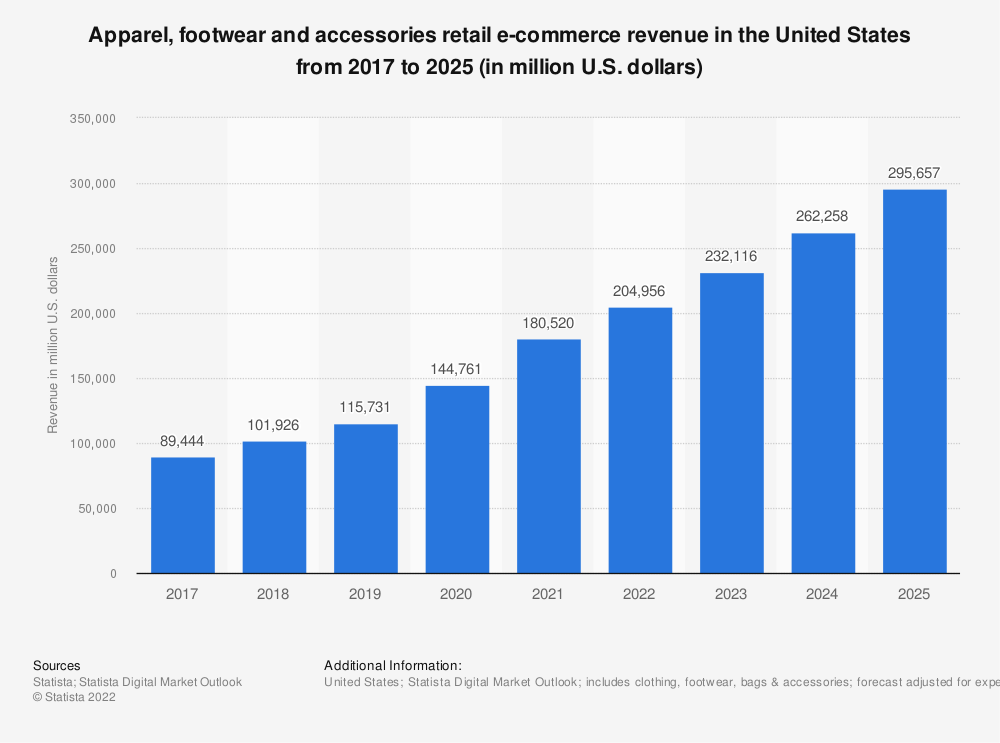
2. The COVID impact
The coronavirus pandemic wreaked havoc on the final few years' fashion ecommerce predictions. When lockdowns were enforced globally in March 2020, 27% of US consumers said they planned to spend "somewhat" or "a lot" less on luxury and manner items than they had approaching prior.
Despite this, McKinsey named it the "perfect storm for fashion marketplaces." Brands like Zalando reported a 32% to 34% growth in gross trade value (GMV) during the 2d quarter of 2020. Fast-fashion brand Shein saw its valuation double to $30 billion, making it the world'due south largest online-only way retailer.
One branch of fashion retail that has taken off is athleisure. Athleisure'south market size was valued at $155.ii billion in 2018—a effigy that'southward set merely to rising.
Casualwear remains dominant on Amazon, with athleisure predicted to have a CAGR of six.7% from 2019 to 2026 and reach $257.one billion. The loungewear and sleepwear market shows similar signs of growth, poised to increase by $19.5 billion between 2020 to 2024.
The result? Fashion brands with an ecommerce shop maintain a stronghold in athleisure, similar Nike and Lululemon, have reported incredible growth over the course of the pandemic.
3. Wearable and apparel
Lower digital barriers to entry for all clothing merchants offer the opportunity to market, sell, and fulfill orders globally and automatically. Every bit a result, worldwide revenue and revenue per user (ARPU) are both projected to abound.
In the US alone, the clothes and accompaniment industries accounted for 29.5% of all ecommerce sales in 2021. In Europe, it's expected that by 2025, each consumer volition spend $999 on fashion-related items over the course of a year.
4. Shoes segment
As a segment of ecommerce fashion, the shoe industry saw similar peaks in marketplace value. In global market size, the footwear segment will increment from $365.5 billion in 2022 to $530.3 billion in 2027.
Asia is dominating this segment, property 54% of the global footwear market (compared to just 14.8% for Europe and N America, respectively).
Athletic footwear is also a growing segment, tipped to generate $63.5 billion in 2023—a 23% increment from the $51.four billion valuation in 2020.
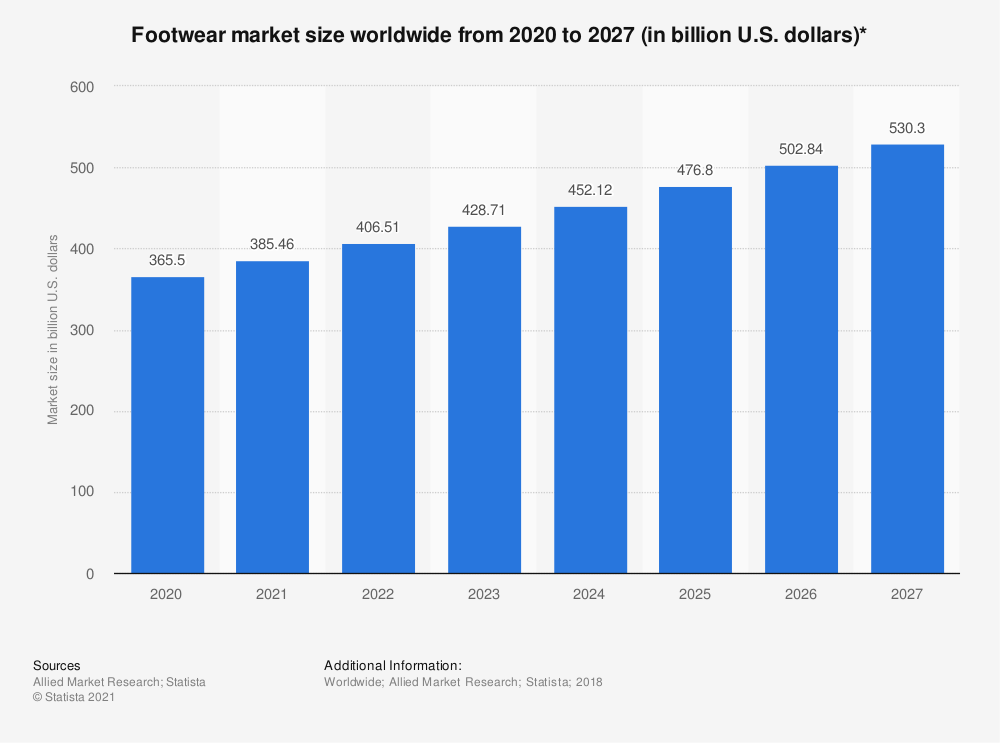
five. Accessories and numberless
Non surprising, the bags and accessories segment—although even so growing at a stronger rate—will likewise see double-digit growth. The fashion accessory segment volition accept a CAGR of 12.3% between 2016 and 2026, with Asia-Pacific beingness the fastest growing marketplace.
Those projections actually make bags and accessories one of the healthiest segments of ecommerce fashion, despite its absolute numbers beingness the smallest.
half-dozen. Jewelry and luxury
In 2020, the global jewelry market was valued at a total of $228 billion. It's forecasted to reach $307 billion by 2025, with ecommerce sites expected to facilitate twenty.viii% of sales in the luxury goods category this year. Luxury watches are set to take a huge piece of that revenue—customers will spend $9.three billion on them in 2025.
The growth (despite coronavirus-related recessions) mirrors other financial crises. McKinsey predicted that consumers volition "return more rapidly to paying full price for quality, timeless goods, as was the case after the 2008–2009 financial crisis."
Increasing abundance in Asia-Pacific and in the Heart East collection upward the average acquirement per luxury adept consumer to $313. Despite luxury goods sales seeing sluggish growth, at iii.four% annually, McKinsey forecasts indicate that ecommerce could triple in sales over the next decade—reaching €70 billion ($79.5 billion) by 2025.
The biggest threat is the affordable luxury market: Should the industry offer luxury goods at multiple price points to grow the market overall? Or will affordable luxury dilute or erode the high-end luxury market—dampening consumer confidence that what they are buying is "truthful luxury"?
Ecommerce fashion industry: trends and strategies for 2022
The above data points offering a wealth of growth opportunities for fashion and clothes retailers—despite the huge shifts in consumer behavior, global trade, and "normal" day-to-twenty-four hours lives for millions effectually the world.
Beneath are some of the latest ecommerce trends that you tin work into your long-term manner sales strategy.
- Personalization is a balancing act
- Into the metaverse
- Brand-building over paid ads
- Sustainability at the forefront
- Social commerce
- The transition dorsum to brick-and-mortar
Personalization is a balancing human action
Personalization has long been hailed as the secret of modern ecommerce. By showing items a shopper was previously interested in, or retargeting them based on the activity they've had with your ecommerce website, you're providing a tailored online shopping experience—i that convinces them to buy.
Our research shows that 44% of customers are OK with brands using their personal information to personalize messaging and improve the customer experiences, such as production recommendations. But at that place's a fine line.
Online shoppers are increasingly concerned about their privacy. Too much personalization can be creepy, hence why brands that over-personalize are three times more likely to be abandoned past shoppers.
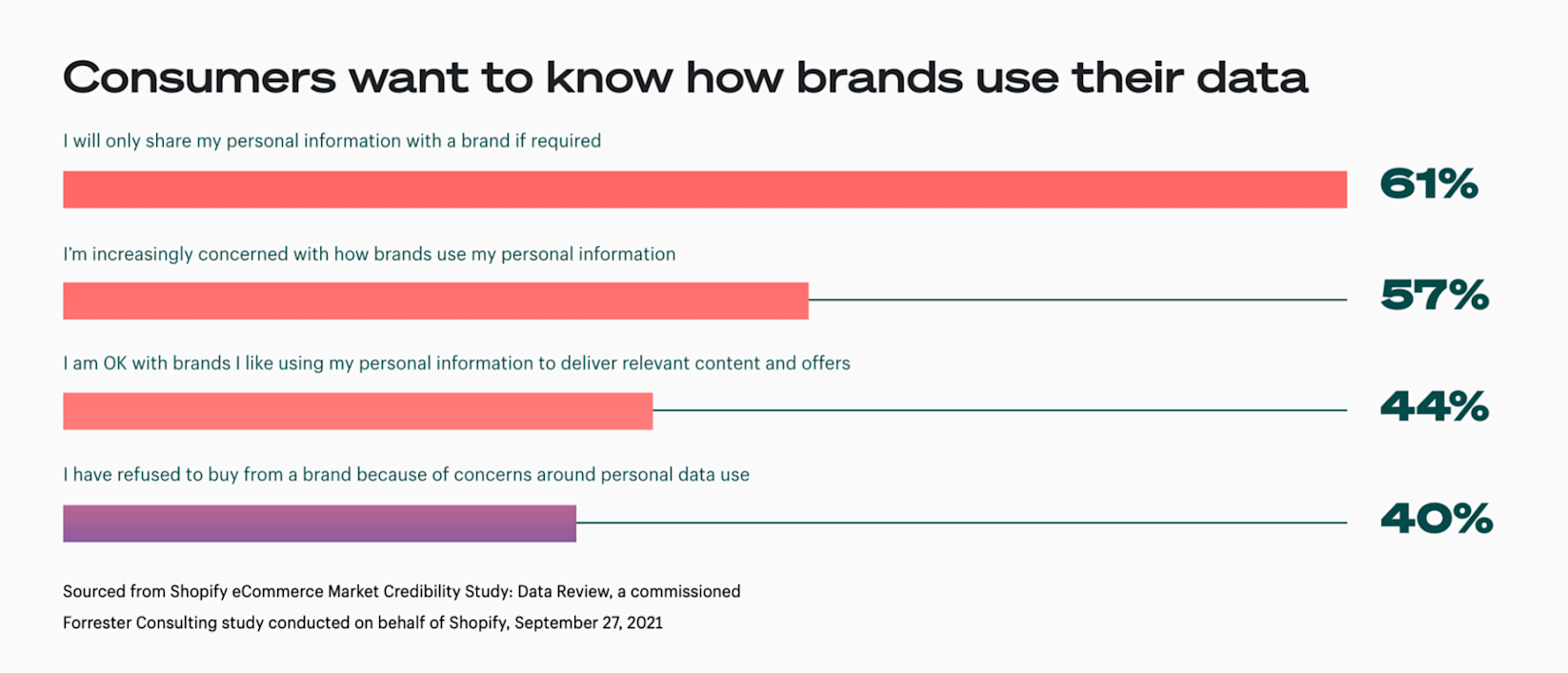
Culture Kings is the perfect example of how fashion ecommerce brands can remainder under- and over-personalization. Instead of customizing the experience downwards to "first name" tags on the website, information technology built four global storefronts to sell in different currencies. The result? More than than one-half of the style brand's revenue now comes from its ecommerce business organization.
I believe nosotros'll encounter more than local brands branching out and offer customized shopping experiences for international customers to remain competitive. This will include things like geo-targeted domains, pricing in local currency and local product shipping, with the help of 3rd-party distribution or company owned warehouses."
—Leanne Lee, Marketer at Blue Bungalow
Into the metaverse
The definition of "metaverse" is open to interpretation. The not-quite-defined promise of virtual societies is nevertheless in development, though the idea is that people can conduct daily activities—similar connecting with friends, playing a game, and purchasing products—through an online, virtual earth.
One blazon of item that functions both in and out of the metaverse are non-fungible tokens (NFTs)—unique digital tokens that tin only be owned by i person, usually paid for in virtual currency like crypto. Data shows $87.03 million was spent on NFTs on January 1, 2022, alone.
Celebrities like Reese Witherspoon were mocked for predicting, "In the (virtually) future, every person will take a parallel digital identity. Avatars, crypto wallets, [and] digital goods volition be the norm."
In everything nosotros exercise, nosotros're helping the customer imagine. We want them to imagine being the man in every moving picture. To imagine us being their stylist. To imagine, 'That could be me wearing those clothes.' We're not so much curating content every bit curating imagination."
—Kevin Dao, Co-founder and CEO/CCO at ORO LA
In reality, fitness apparel brands similar Under Armour are experimenting with NFTs in the retail space. Its Steph Back-scratch collaboration reproduced shoes the basketball star wore when he bankrupt the NBA record as all-time height three-point shooter.
Digital NFTs were released alongside the physical production launch. Owners of the NTFs could nearly clothing the shoes in iii metaverses: Decentraland, The Sandbox, and Gala Games.

Retailer Forever 21 partnered with Roblox to create virtual stores in its metaverse, appropriately named the Forever 21 Shop City. Players run the virtual store as if information technology was their own, and purchase merchandise for their avatar through the game.
With Forever 21 Shop Urban center, our goal is to expand how we engage with customers, extending our presence and product in new ways."
—Katrina Glusac, principal merchandising officer at Forever 21
Fast-fashion retailer PrettyLittleThing as well recently began showcasing products on virtual models. The brand posted the news to its Instagram page, turning its new "avatar in the metaverse" concept into a contest to spark conversation.
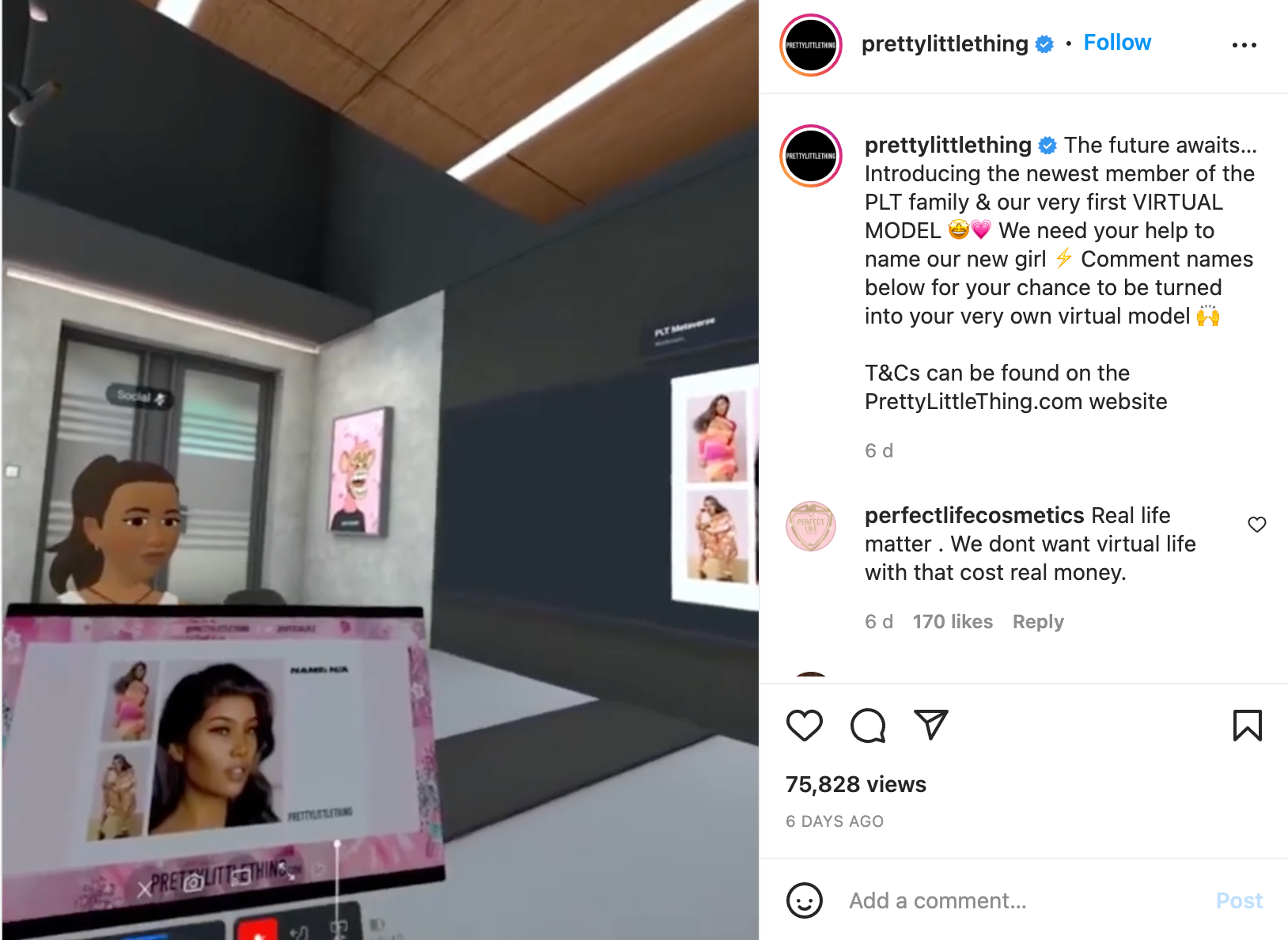
Just similar Fortnite community inspired Balenciaga'southward designs, fashion companies can motility towards becoming creative collectives. Each collection can accept its own identity within the brand universe, reputation, and community. Collectives can focus on the actual production designs and/or on content creation, with associated royalties based on detail/content performance, delivering returns to creators in perpetuity and ensuring that a brand attracts the very top talent."
—Ana Andjelic, Founder of The Sociology of Business
Brand-building over paid ads
To say fashion ecommerce is saturated would be an understatement. Consumers accept more choice than ever before—making it difficult to drive loyal customers back to 1 item online shop.
Unfortunately, that means brands are competing against thousands of competitors when ad their products to their target marketplace. Some 41% of brands plan to increase their investment in paid search. This rush of upkeep meant that betwixt the 2nd and third quarters of 2021, the cost per click (CPC) of paid search ads increased by xv%.
It's an increasingly dour movie when combined with the "death of the cookie." Technology giants similar Google plan to restrict brands from collecting cookies in its browser by 2023. Some 28% of technology conclusion makers expect this change in regulation to hinder their 2022 growth goals.
One culling to expensive advertising and express customer data? Brand building. Studies show companies that invest in branding see more than organic acquisition and customer retentivity rates. They also find it easier to increment profits since customers of stiff brands are more than receptive to price hikes.
One clothes brand leaning into this strategy is Noémie. Yuvi Alpert, its founder, Artistic Director, and CEO, says the make balances both performance marketing and brand building: "We wanted to move away from typical short class advertising that did not draw an emotional connection to our products, which is why we diversified our promotions and the channels we utilized to feature narrative ads.
"Narrative or storytelling promotions had share rates of upwardly to twenty%, and in recognizing this fact, we decided to research the best ways to implement that strategy.
"By creating storylines about our customers, and so placing those in content rich formats such equally blogs, newsletters, and emails, we constitute dramatic increases in appointment rates over the typical banner ads or curt videos on social media.
"In improver, they were far more price effective and could easily exist repurposed. By moving to a storytelling technique, we increased date rates while bringing down our CPA."
Sustainability at the forefront
The fashion industry is no stranger to criticism. Fast-fashion brands especially are (sometimes rightly) chastised for the methods they use to manufacture and produce inventory.
In light of these criticisms making mainstream news, plus consumers' increasing commitment to eradicate climate change, some 52% of shoppers say they're more likely to purchase from a company with shared values.
An important value for modern fashion consumers? Sustainability. Statista'due south inquiry shows 42% of global customers purchase eco-friendly and sustainable products. Certain countries are leading the trend—online shoppers in Vietnam, Bharat, and the Philippines purchase sustainable products more than often.
With people spending more time online, information technology is going to facilitate faster exchange of that information [nigh suppliers]. We've become more aware of how things that happen in far flung places affect us and the planet. That'due south been a real primal change we've seen."
—Grace Beverly, Founder of TALA
Purchasing habits are also shifting off the back of the pandemic. Some 65% of customers program to purchase more durable manner items, with 71% planning to keep the items they already have for longer. The manner resale marketplace is booming for this reason—growing 11 times faster than traditional retail and tipped to reach a $77 billion valuation in the next v years.
Patagonia is one dress brand with sustainability rooted in its brand values. The retailer actively campaigns for ecology causes, and demonstrates its commitment to sustainability with its Worn Wear program. Shoppers are encouraged to buy and sell used items instead of buying new.
We're proud to offer our customers a conscious shopping choice with sustainable, affordable pieces that are all handpicked and on tendency, but nosotros believe every brand needs to take responsibility, and button themselves to become more circular."
—Kate Peters, Managing Director of Beyond Retro
Social commerce
Social media plays an integral role in the ecommerce marketing strategy of many online manner brands. That's hardly surprising—our smartphone addiction is out of control. The typical social media user now spends well-nigh fifteen% of their waking life glued to an online networking app.
Only the truth is: social media is no longer a identify for shoppers to consume new fashion trends. Many social media platforms are evolving their business models to facilitate in-app shopping, helping online retailers accomplish customers actively in the purchasing frame of mind.
Social commerce sales are expected to almost triple by 2025, with more than than one-3rd of Facebook users planning to make a buy directly through the platform in 2022.
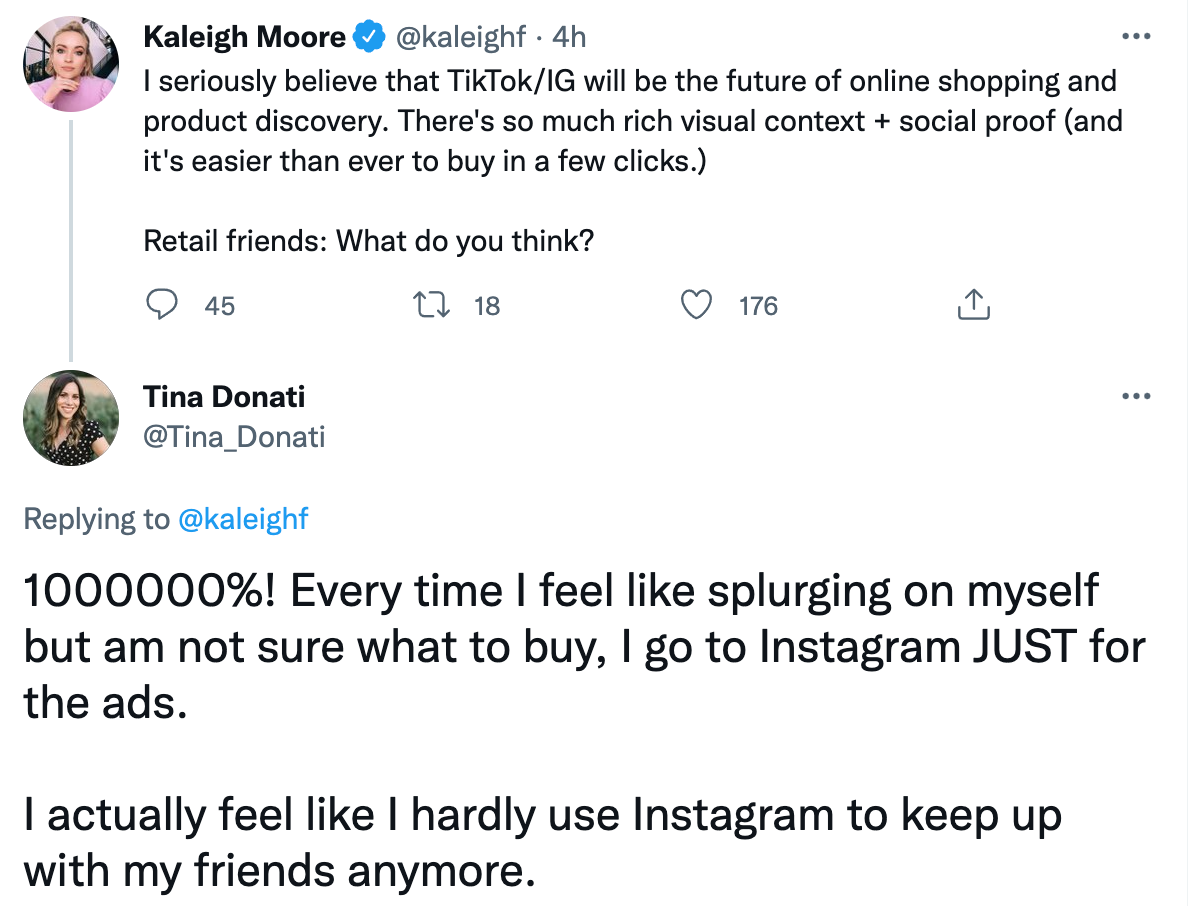
Unfortunately, almost brands are plagued by a single sin. Andy Crestodina, co-founder of Orbit Media, describes the situation perfectly: "Most branded content is advertizing under a thin layer of data or entertainment. Scratch the paint, find an ad. It'southward the brand putting itself outset."
Thankfully, mode and social media are a lucifer made in ecommerce heaven. Even when it comes to explicitly "branded" content, and especially on Instagram.
Social media engagement rates for global fashion brands are abysmal:
- Instagram: 0.68%
- Facebook: 0.03%
- Twitter: 0.03%
So, what types of content is working for mode brands? Some 46% of consumers want to watch product videos before they buy. Platforms like TikTok and Instagram are praised for driving sales for large fashion brands since shoppers can visualize the production on a real person. Bonus points if it's a social media influencer they already trust.
Long gone are the days of celebrities being only someone you lot'd see on TV. Today, anyone with a passion can go a glory in the social media niche—partly due to the rise of entertainment platforms similar Instagram, LinkedIn, and Twitch.
Across influencer marketing on social media, multi-channel ecommerce integrates native selling off site to build direct buying paths in the places your audition spends their time. Social media platforms are creating their own commerce features—similar Shopping on Instagram, Facebook Shops, buyable pins on Pinterest, and more.
Livestream shopping is besides in its heyday. Nordstrom launched its own livestream shopping channel last year. Information technology's in proficient company: 81% of companies program to increase or maintain their investment in livestream selling to drive sales over the coming yr.
Why? Because online brands are seeing conversion rates of up to 30% through Facebook and Instagram livestreams, along with lower product return rates.
My prediction is that in a couple years, the hottest role for a brand to rent is going to exist a caput of alive shopping."
—Kevin Gould, Co-founder of Glamnetic
The transition back to brick-and-mortar
The shopping experience is more complex than e'er—specially in the fashion infinite. Some 22% of online returns happen because the product ordered online looks differently in the mankind. Information technology'southward this never-ending challenge that's driving many manner brands back into traditional retail.
The time to come is neither ecommerce or retail. Information technology'due south just commerce. And so the question becomes, 'How practise you symbiotically integrate both channels?'"
—Hemant Chavan, founder of Brik + Clik
Data compiled in the Time to come of Commerce report proves omnichannel commerce isn't disappearing anytime soon. Modern consumers desire both online and offline sales channels—and synergy between the two:
- 54% of consumers are probable to look at a product online and purchase it in a physical shop.
- 53% vision themselves doing the contrary: viewing products in-store and buying it online.
- 55% of consumers want to browse products online and check what's bachelor in local stores.
- Over 50% of adult shoppers use BOPIS, with 67% adding extra items to their carts when they tin pick them up immediately.
Brands investing in brick-and-mortar retail include Canadian fashion brand SMYTHE, which opened its shop in Toronto. Afterwards years of experimenting with pop-up shops, Gymshark too opened its offset permanent flagship store in cardinal London.
"A children's wear retailer I spoke to pivoted from in-store events to virtual shopping events via Zoom during COVID," says Kyle Monk, Managing director of Insight, British Retail Consortium.
"Suddenly, they were having one fellow member of staff walking effectually the shop selling products to ii to 300 people per call every calendar week, instead of merely a few in person. Retailers who thought innovatively and pivoted thrived over the last period."
It's no wonder 53% of brands are investing in tools that allow them to sell anywhere.
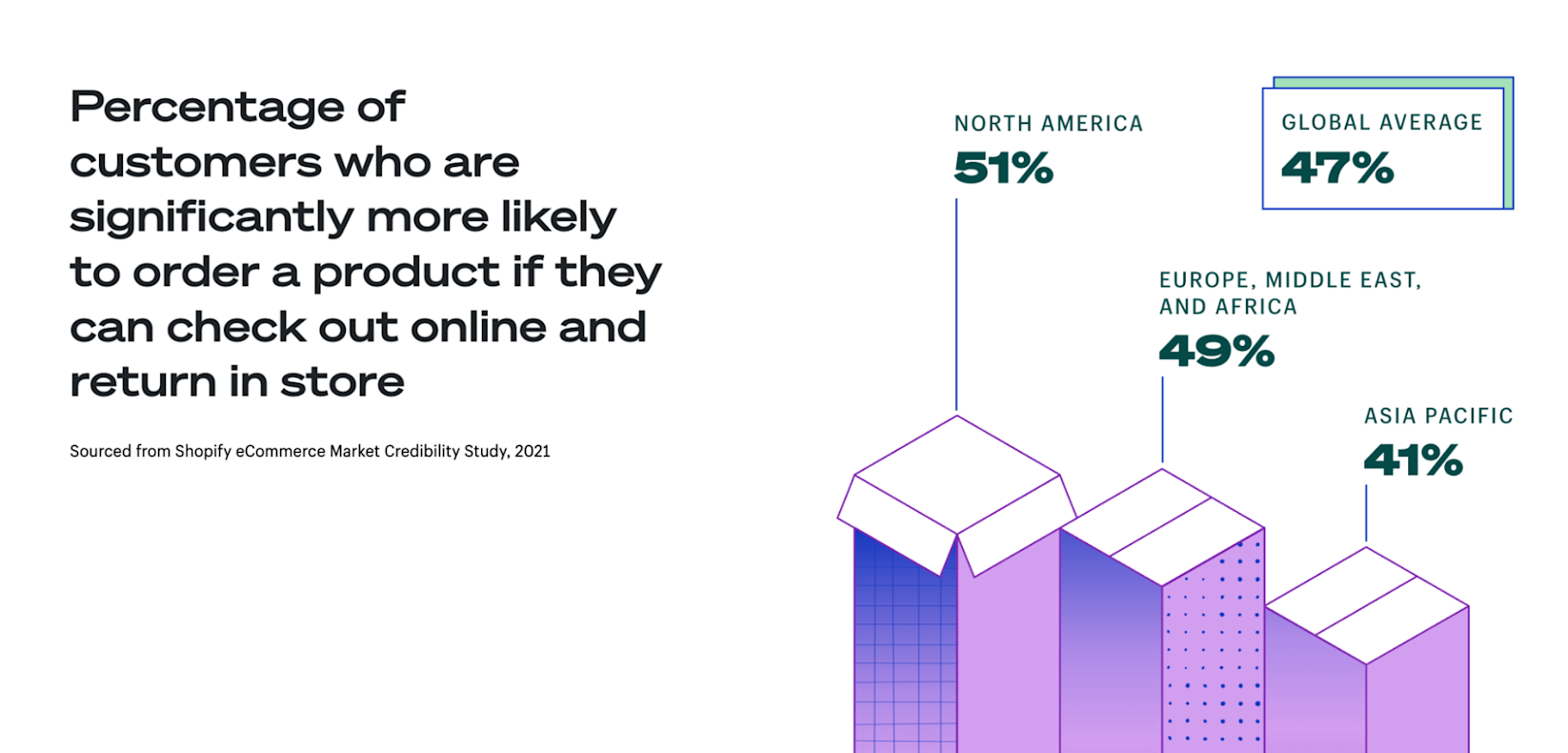
Want more near the state of ecommerce way?
The state of ecommerce fashion is developing more speedily than ever. What worked two years ago is outdated now—largely due to consumer preferences changing, values becoming integral to the purchase decision, and footfall returning to brick-and-mortar stores.
Read our Time to come of Commerce report and get the ecommerce trends, insights, and communication you need to succeed in 2022:

0 Response to "Ways to Increase Sales for Fashion Retail Store"
Post a Comment